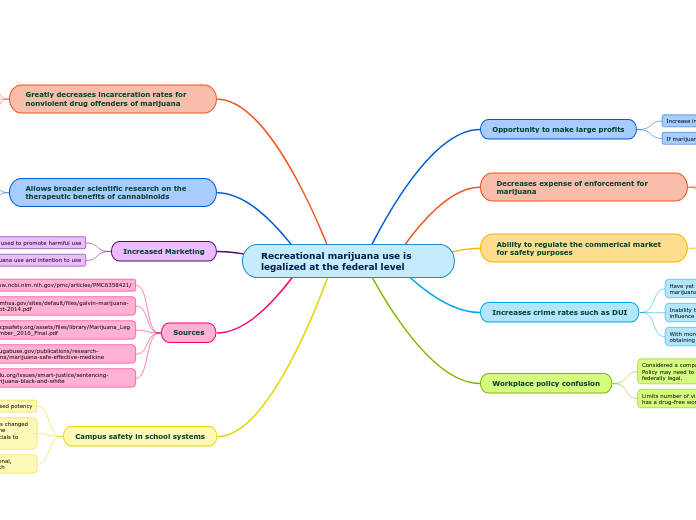Recreational marijuana use is legalized at the federal level
Opportunity to make large profits
Increase in production = increase in jobs
If marijuana is taxed, increase in revenue for the state
Decreases expense of enforcement for marijuana
DEA can spend less time/energy/money enforcing marijuana and more time on enforcing illicit drugs
Marijuana arrests now account for over half of all drug arrests in the United States
Enforcing marijuana laws costs us about $3.6 billion a year
Ability to regulate the commerical market for safety purposes
To negate accidental ingestion by children/animals, stricter packaging and labeling requirements can be put in place
Place a limit on how much marijuana is sold to a party
Increases crime rates such as DUI
Have yet to create a standardized measure for the unit of marijuana consumption
Inability to quickly determine if someone is under the influence of marijuana except via blood or urine tests
With more availability, minors will have higher chances of obtaining or buying and using marijuana
Workplace policy confusion
Considered a companies right to uphold a dug-free workplace. Policy may need to be adapted if marijuana was to become federally legal.
Limits number of viable employee's to a given company that has a drug-free workplace policy
Greatly decreases incarceration rates for nonviolent drug offenders of marijuana
The war on marijuana has failed to reduce marijuana use and availability and diverted resources that could be better invested in our communities
When people are arrested for possessing even tiny amounts of marijuana, it can have dire collateral consequences that affect their eligibility for public housing and student financial aid, employment opportunities, child custody determinations, and immigration status
Despite roughly equal usage rates, black people are 3.73 times more likely than white people to be arrested for marijuana
Allows broader scientific research on the therapeutic benefits of cannabinoids
THC medications in pill form have had success treating nausea in patients undergoing cancer chemotherapy and to stimulate appetite in patients with wasting syndrome due to AIDS
Further research will be needed to determine whether people whose health has been compromised by disease or its treatment (e.g., chemotherapy) are at greater risk for adverse health outcomes from marijuana use
Increased Marketing
Advertising used to promote harmful use
Can influence adolescent marijuana use and intention to use
Sources
Campus safety in school systems
Health and safety challenges due to drug's increased potency
Chemical nature and physical form of marijuana has changed significantly in the last 20 years, which can make the consumption and use more difficult for campus officials to detect
World of marijuana is changing faster than educational, training, and enforcement efforts can keep pace with
